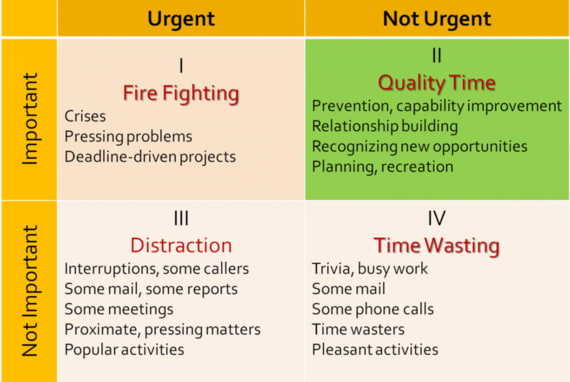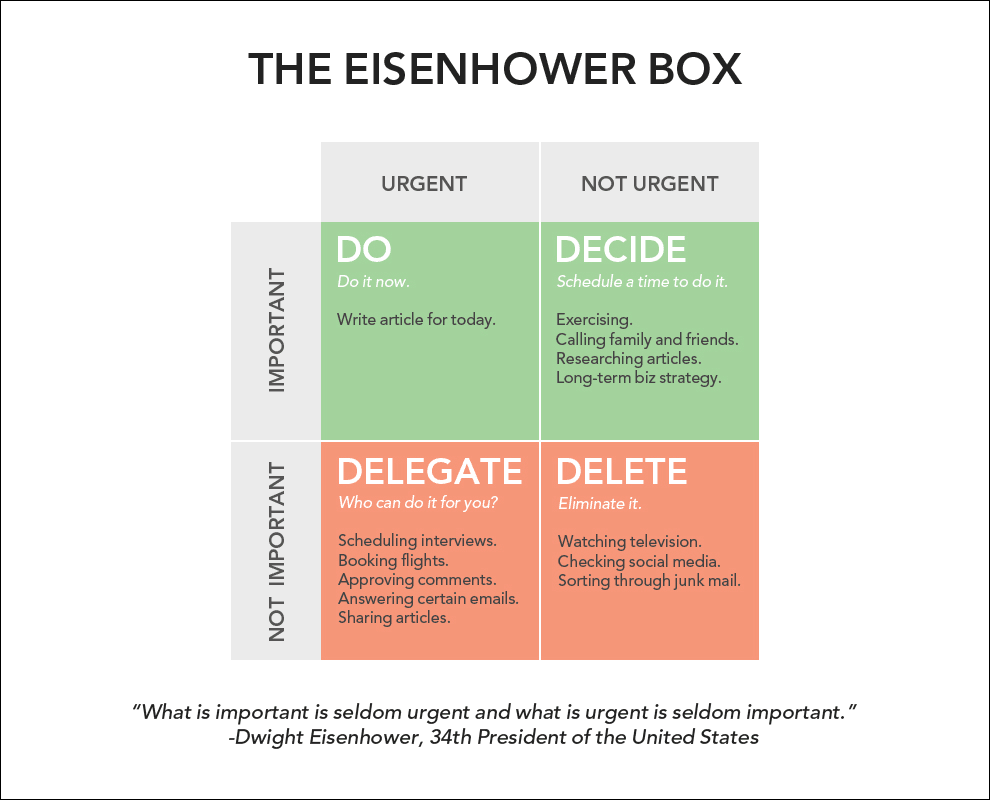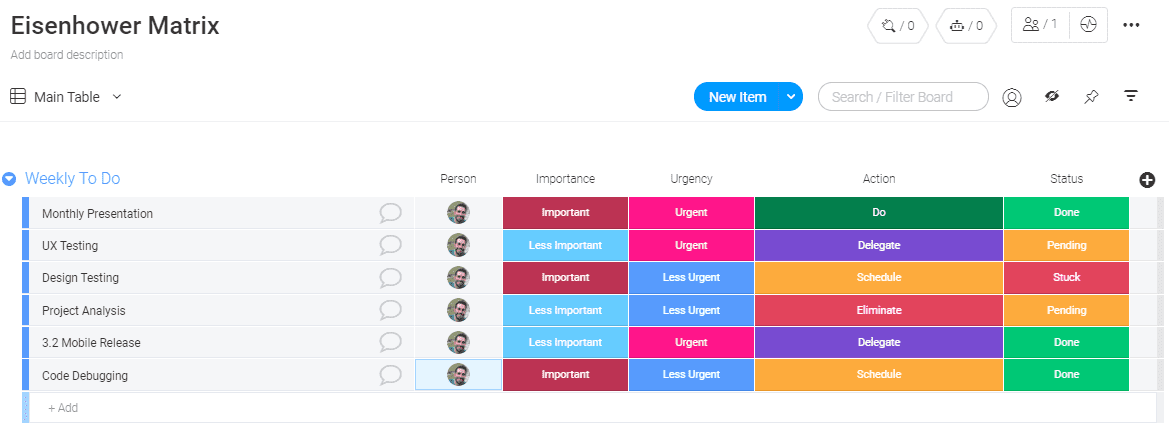More likely than not you know someone who seems to have boundless energy and get more done in a week than you do all month— are they superhuman, or could it be a time management matrix?
This project management tool can help you not only manage your time spent on work but also improve the prioritization of that work. In this article, you’ll learn what a time management matrix is, including who uses them, how to create one, and how monday.com makes it even easier to be more productive.
What is a time management matrix?
Defining the time management matrix is a bit tricky since there are so many facets that make it effective.
In simple terms, a time management matrix is a productivity tool. It helps identify what’s truly important, so you spend more time on what matters most.
You might have also heard it called a time matrix, the Covey time management matrix, or the 7 Habits time management matrix. Its foundation rests on 2 words: important and urgent. Important means significant or valuable, while something urgent requires immediate attention or action. It’s crucial to remember that not all urgent tasks are important and vice versa. The time management matrix helps you rank an item’s importance and urgency simultaneously and places it in the correct quadrant (more on that in a moment). Urgency is pretty simple to figure out. You’ll often know if something needs completion today, a week from now, or if it doesn’t technically have a due date or sense of urgency. Determining task importance is a bit trickier.
Who should use a time management matrix?
It may sound cliche, but just about anyone can benefit from using a time management matrix to help complete their daily tasks. Anyone who juggles a large task load would likely benefit most from a time management matrix because it helps you collect information and turn it into an actionable workload.
Why is time management so important?
The average office worker is only productive about 2 hours and 53 minutes each day. Between using the restroom, checking social media, chatting with co-workers, and the constant barrage of interruptions, there’s not a lot of pure focus time. Time management helps prioritize tasks, so you’re focusing your finite time and resources on the right tasks.
Highly effective people — former President Dwight D. Eisenhower and Stephen Covey, author of “7 Habits of Highly Effective People”, for example — have the common habits of harnessing their time management skills to focus more intently when studying or working. They start and end on time and ensure they don’t feel rushed by a fast-approaching deadline or random urgent tasks they didn’t foresee.

Time management reduces stress, helps produce better work, and in all likelihood, will improve your career opportunities since you’re using your work time more productively than your peers.
How to create a time management matrix
Creating a time management matrix starts with a simple structure: 4 boxes with 4 words around the left and top side of the boxes: Not important, important, urgent, and not urgent. From there, it’s as easy as penciling your tasks into the correct cross-section box and taking action.

With a digital time management matrix — like what you can build in monday.com — users and visitors interact and customize this data much more simply with a drag-and-drop interface. All you have to do is type your tasks in and flag them by their importance, urgency, or lack thereof. The system will automatically place them accordingly. Let’s look at how to categorize tasks and how you should tackle tasks in each category.
Urgent, important
These tasks should be rare, and as the title implies, they’re things you do immediately. People often refer to these as quadrant I tasks. If you don’t perform these urgent, important tasks, there will likely be immediate consequences. You’ll miss an opportunity, occur some sort of loss, or suffer poor performance.
Important, urgent things are often thought of as “fire fighting.” If your company was hacked and you have the opportunity to thwart the criminal before they do too much damage or steal sensitive data, then that definitely qualifies. If a customer calls and says that they’re ready to purchase the biggest deal your company has seen all year, then that’s one of those “drop everything you’re doing” urgent and important moments.
Important, not urgent
Quadrant II tasks are important, but not urgent. If urgent, important is rare, then you likely have a backlog of important, not urgent items on your task list.
To tackle urgent, not important items, you’ll want to schedule large blocks of uninterrupted time to work on them if you can. The longer, the better, so you can get into a flow state and truly focus.Important tasks contribute greatly to your life or company’s mission and strategic goals. It’s the stuff you’re remembered by and makes the greatest impact on the world. This includes things like improving work processes, completing additional training, and capturing lessons learned.
Urgent, not important
Quadrant III tasks are things you’ll ideally delegate to someone else or automate if you can. Sometimes the best thing to do is manage them or chunk them together, so they don’t disrupt the important tasks.
Ultimately, you want to spend as little time as possible on urgent, not important, tasks. They’re counterproductive tasks that likely don’t contribute much to your greater goal, are low on the priority list, and add fog to your daily life that’s hard to see through.
Not urgent, not important
Quadrant IV is not urgent, not important, which means it’s likely not worth doing at all. Think of quadrant IV as a black hole. As you spend more and more time there, you just get sucked further in until you’ve lost all momentum and energy to work on important things.
The kind of activity that lacks importance or urgency includes:
- Sorting through junk mail
- Mindlessly browsing social media
- Flipping through television shows
- Attending meetings that aren’t relevant to you or your long-term goals.
How to automate your time management matrix with monday.com
monday.com takes time management matrices to the next level with a beautiful board that adds even more functionality and productivity. In addition to providing an organized and central place for all your tasks, you can assign them to other people and add comments, files, and other pertinent attachments.
You can create custom statuses for each task in separate columns according to urgency and importance- this makes it easy to visualize which tasks to eliminate, delegate, schedule, or complete.

Plus, at a glance, you can see if you or your colleagues have completed the task, are actively working on it, or if someone’s stuck and is in need of assistance.
You can track daily tasks and long-term goals simultaneously. You can also communicate internally on each task and integrate your monday.com boards with the software you use each day to make you even more productive.
Create your custom time management matrix today
As you can see, monday.com took the time management matrix to the next level by adding automation, mobility, and a beautiful visual that makes it easy to see what’s important or urgent at a glance. If you’re ready to dive deep into your quadrant II tasks, then give our Eisenhower Matrix Template a shot.
